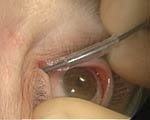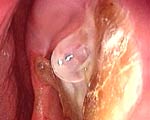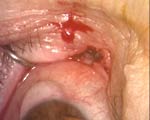Surgeon: Lacrimal surgery with modified Jones tube less invasive
The modified Jones tube is made of PMMA or Teflon instead of Pyrex and will soon be implantable through a specially designed injector.
Endoscopy-assisted conjunctivodacryocystorhinostomy with implantation of a modified Jones tube in a new material is less traumatic and allows faster recovery and long-lasting tear drainage, according to Stefano Cavazza, MD, of the eye unit of Maggiore Hospital, Bologna, Italy.
“Nasal and transcanalicular endoscopy is now a well-established procedure in the diagnosis and treatment of lacrimal duct obstructions. It follows the trend toward minimally invasive microsurgery procedures, which characterizes all branches of ophthalmology from bimanual phaco to vitreoretinal surgery. If on one hand it requires expensive equipment, like endoscopes and lasers, on the other hand it saves on surgical time. Trauma, pain and scars are minimal and recovery is faster,” he said.
Endoscopy-assisted procedure
Conjunctivodacryocystorhinostomy (CDCR) is the last resort when nasal or transcanalicular procedures fail due to lacrimal sac atrophy or post-traumatic lesions or in some cases because of severe canalicular obstruction and canalicular agenesis, Dr. Cavazza said. It can be performed under local or general anesthesia.
“After removal of a small portion of lacrimal caruncle, a 14-gauge catheter is introduced through the medial canthus. When the catheter reaches the maxillary lacrimal junction, which is the weaker point of the bone, perforation is performed,” Dr. Cavazza explained.
At this point, a nasal endoscopic probe is introduced to explore the lacrimal region of the nasal cavity and coordinate surgical maneuvers.
“Using a needle introduced through the medial canthus, the surgeon must enlarge the breach in the nasal bone without damaging the adjacent nasal structures. The tunnel created between the conjunctiva and the nasal cavity is then enlarged by using a standard instrument for punctum dilation with a blunt tip,” he said.
 |   |
| The Bowmann probe is used as a guide to position the Jones tube. | The proximal end of the modified Jones tube is secured at the medial canthus with a 5-0 polyester suture. |
| (Images courtesy of Stefano Cavazza, MD.) | |
Unbreakable tube
The modified Jones tube is then placed using a Bowman probe to make it slide into position. The endoscope is used to make sure that it does not protrude more than 2 mm from the nasal mucosa. The slanted end of the tube must be pointed downward.
“Our version of the Jones tube, which is currently produced by Janach, is made of PMMA or Teflon instead of the traditional Pyrex. These materials make the tube equally biocompatible but safer than the original. Like Pyrex, PMMA and Teflon, which are used in all sorts of ocular implants, are hydrophobic, nonporous, rigid and inert, but they are also unbreakable and prevent this complication. The tube is available in three different sizes: 18, 20 and 22 mm in length,” Dr. Cavazza explained.
To make sure that the tube is not obstructed, irrigation with 50% povidone solution is performed after implantation. The tube is fixed to the internal canthus using 5-0 polyester suture. The entire operation does not last more than 20 minutes, about one-third of the time required for the traditional external technique.
Fewer complications?
CDRC has a success rate of up to 96%, Dr. Cavazza said. However, positive, long-lasting results depend on postoperative care. He said that the tube must be frequently washed and a meticulous endonasal therapy must be regularly carried out to prevent obstruction from mucus plugs or scar formation.
Numerous late complications of the Jones tube are reported in literature. Among them are extrusion, migration, infection, obstruction of the lumen by the surrounding conjunctiva, reflux of nasal secretions, diplopia, toxicity due to eye drops absorption and breakage. “Our case series is made of a limited number of patients (a total of five) with a relatively short follow-up. So far we have only had two cases of conjunctival granuloma, which was removed under local anesthesia,” Dr. Cavazza said.
Although more patients and a longer follow-up are necessary to draw reliable conclusions, he believes that the endoscopy-assisted variation of CDCR might have fewer complications than the traditional approach.
“The smaller, 3-mm diameter tunnel, the less traumatic approach and the new material should cause a weaker cicatricial reaction in the surrounding tissues, and this should give the Jones implant a more long-lasting stability,” he said.
An injector for easier and better implantation of the tube will soon be produced by Janach, Dr. Cavazza said.
For Your Information:
- Stefano Cavazza, MD, can be reached at Ospedale Maggiore, Largo B. Nigrisoli 2, 40100 Bologna, Italy; 39-051-6478608; fax : 39-051-6478945; e-mail: stefano.cavazza@ausl.bologna.it. Dr. Cavazza has no financial interest in the products mentioned in this article.
- E. Janach srl, can be reached at Via Borgo Vico 35, 22100 Como, Italy; 39-031-574-088; fax: 39-031-572-055; e-mail: international@janach.it.
References:
- Trotter WL, Meyer DL. Endoscopic conjunctivodacryocystorhinostomy with Jones tube placement. Ophthalmology. 2000;17:1206-1209.
- Bartley GB, Gustafson RO. Complications of malpositioned Jones tube. Am J Ophthalmol. 1990;109:66-69.
- Hartikainen J, Grenman R, Puukka P, Seppa H. Prospective randomized comparison of external dacryocystorhinostomy and endonasal laser dacryocystorhinostomy. Ophthalmology. 1998;105:1106-1113.
- Steindler P. Trattamento chirurgico ab esterno delle stenosi canalicolari. In: Steindler P. Il Sistema lacrimale. Fabiano Editore 2000 cap. 19.
- Cavazza S, Presutti L, Tassinari G. Stenosi del dotto nasolacrimale e patologie delle cavità nasali: implicazioni etiopatogenetiche. Ottica Fisiopatologica. 2003;1:37-41.
